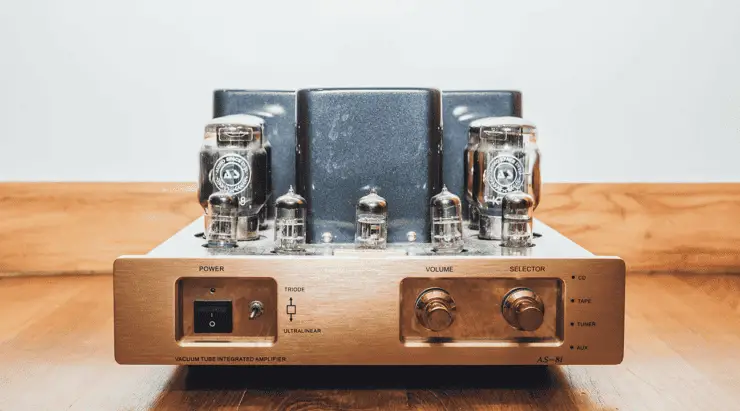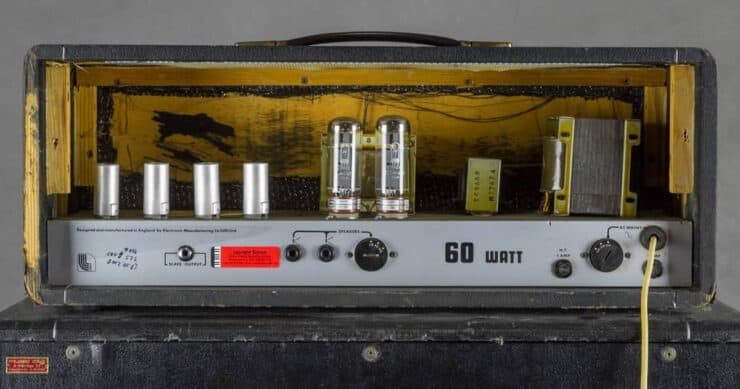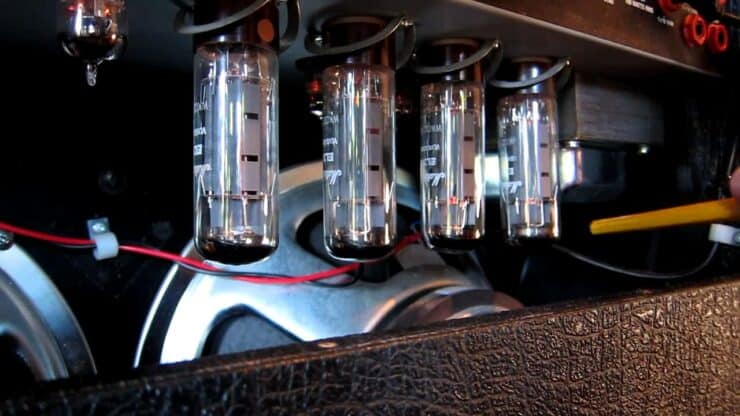Whether you’re a beginner or a seasoned pro, cleaning the tubes in a tube amp is an essential part of routine maintenance for any guitar player. Keeping your amp in top shape will ensure you get the best sound out of it and will help prolong the life of your equipment. In this article, we’ll take a look at the best practices for cleaning the tubes in a tube amp and provide tips on how to do it correctly. So, if you want to maximize the performance of your tube amp, keep reading to find out all the information you need!
Overview of tubes in tube amps
Tubes or also known as vacuum tubes or valves are the electronic components used in guitar amps for amplifying and shaping the sound of an electric guitar. Tubes are made from glass or metal and have a filament that heats up to produce electrons. These electrons are then accelerated by an electric field for creating a lot of current.
There are different types of tubes used in guitar amps, with each of them having its own unique characteristics and sound. Here are the different types of tubes in tube amps –
#1. Preamp tubes
Preamp tubes, or also known as small signal tubes, are responsible for the initial amplification of the guitar signal. They’re typically smaller and produce less power compared to power tubes. Some of the common preamp tube types include 12AX7, 12AT7, and 12AU7.
#2. Power tubes
Power tubes, or also known as output tubes, are responsible for amplifying the guitar signal to a level that can drive the speakers. They are typically larger and produce more power than preamp tubes. The common power tube types include 6L6, EL34, and EL84.
>>> Click here to read our review about the Top 15 Best Tube Amps <<<
#3. Rectifier tubes
Rectifier tubes are responsible for converting AC voltage to DC voltage. They can have a significant impact on the sound of the amp, with different types producing different levels of sag and compression. Some of the common rectifier tube types include 5AR4 and GZ34.
#4. Other types
Some guitar amps may also use tubes for other purposes, such as reverb or tremolo effects. These tubes are typically smaller and produce less power than preamp or power tubes.
Each type of tube comes with its own unique sound characteristics, with some of them producing a warmer and smoother sound. Meanwhile, others produce a more aggressive, distorted sound. Guitarists might experiment with different kinds of tubes for achieving their desired tone.
It is important to note that tubes come with a limited lifespan and will ultimately have to be replaced. The lifespan of a tube will vary depending on factors like usage and operating conditions. Many guitarists prefer the sound of older, worn-in tubes, whereas others prefer the consistency of new tubes. It is recommended that you should consult the manufacturer’s guidelines and consult a professional when you’re replacing tubes in a tube amp.

Cleaning tubes in tube amps
Tubes in the tube amps amplify the electrical signals produced by an electric guitar by producing the warm, rich sound that the amps are known for. However, like any other component of a tube amp, the tubes require regular maintenance to ensure they function properly and deliver the best possible sound.
An important aspect of tube maintenance will be cleaning. Over time, dust and other particles can easily accumulate on the surface of the tubes. This buildup can interfere with the tube’s ability to dissipate heat, which can lead to premature failure or reduced performance. Moreover, dust and debris can interfere with the tube’s ability to amplify the guitar signal, which can result in a distorted or weak sound.
Cleaning the tubes in your tube amp involves removing the tubes from the amp and gently wiping them down using a clean, dry cloth. It is important that you avoid getting any cleaning solutions or water on the tubes, as it could cause damage to the delicate components inside.
Aside from cleaning the tubes themselves, it’ll be important that you clean the sockets and pins that hold the tubes in place. Dust and debris can often accumulate in these areas, resulting in poor contact between the tubes and the amplifier. This can result in reduced performance or even damage to the tubes or amplifier.
Regular tube cleaning will be a key aspect of tube amp maintenance. By keeping the tubes and sockets clean, you will be able to ensure that your tub amp is operating at peak performance and delivering the warm, rich sound that tube amps are famous for. Moreover, regular maintenance can help in extending the lifespan of the tubes and reducing the need for costly replacements and repairs.
Signs of dirty tubes in tube amps
Tube amps are quite popular among guitarists thanks to the warm and dynamic sound they provide. However, like any other type of amp, tube amps need proper maintenance to ensure that they operate at their best. One of the key aspects of tube amp maintenance is keeping the tubes clean. Dirty tubes can result in poor sound quality, reduced performance, and tube failure. There are a few common signs that you will need to look out for, as they’ll tell you it’s time to clean the tubes. Here are some of the signs of dirty tubes in tube amps that you should look out for.
#1. Poor sound quality
Dirty tubes can result in a wide variety of sound issues, including a reduction in volume, a loss of clarity, and an increase in noise or hum. You might notice that the guitar sounds dull or lifeless, or that your tube amp is producing a lot of background noise. If you hear any of these symptoms, it might be time to clean or replace the tubes in your tube amp.
#2. Distortion or clipping
Dirty tubes can result in distortion or clipping in the guitar signal. This typically occurs when the tubes aren’t able to amplify the signal properly, resulting in a distorted or clipped sound. You might notice that your guitar sounds buzzy or harsh, especially when playing at a higher volume.

#3. Unexpected overheating
Overheating can be a common sign of dirty tubes. If the tubes in your tube amps are covered in dust or debris, they might not be able to dissipate heat effectively. Overheating can result in premature tube failure or reduced performance. If the amp feels excessively hot to the touch, it might be time to clean or replace the tubes.
#4. Reduced volume
If you notice that your tube amp is providing less volume than normal, then dirty tubes might be the culprit. Dust and debris on the tubes could reduce the ability to amplify the guitar signal, resulting in a weaker sound. You might also notice that your amp is struggling to reach the same volume levels it used to.
#5. Intermittent issues
Intermitted issues with your tube amp can also be a sign of dirty tubes. These issues might come and go, but they could be more noticeable at certain times or in certain playing situations. For instance, you might notice that your amp sounds fine when you first begin playing but then starts producing a lot of noise or distortion after a few minutes.
Dirty tubes can cause many issues with the tube amps. If you notice any of these signs, it might be time to clean or replace the tubes in your tube amps. By keeping the tubes clean and well-maintained, you’ll be able to ensure that your tube amp delivers the warm, dynamic sound that it is known for.
Benefits of clean tubes in tube amps
Tubes are an integral part of tube amps, which are a widely used type of guitar amp. Over time, the tubes in the tube amps can become dirty because of various factors like dust, oxidation, and grime. When tubes become dirty, it can have a negative impact on the sound and overall performance of the amp. That is why it will be important to clean the tubes in the tube amp periodically. Aside from that, there are many other benefits of cleaning tubes. Here are some of the primary benefits of clean tubes in tube amps –
#1. Improved sound quality
Dirty tubes can result in a muffled or distorted sound, which can be a source of frustration for guitarists. Cleaning the tubes can help in removing the accumulated dirt and grime, which can result in a cleaner and clearer sound. This can help in improving the overall tone and dynamic range of the amp.
#2. Longer tube life
Tubes that aren’t cleaned regularly could become damaged over time, which can result in shorter tube life. By cleaning the tubes regularly, musicians and guitarists can help to ensure that their tubes last longer, which can save them money eventually.
#3. Increased reliability
When tubes become dirty, they can become more prone to failure or malfunction. By cleaning the tubes, guitarists could help to ensure that their amp remains reliable and functions properly.
#4. Better overall performance
Clean tubes will help in ensuring that the tube amp is performing at its best. This will result in a more responsive and dynamic playing experience, which can be quite important for guitarists who are performing live or recording in a studio.
#5. Easier troubleshooting
When tubes are dirty, it can be difficult to diagnose problems with the tube amp. By cleaning the tubes regularly, guitarists can help to eliminate one potential source of problems, which makes it easier to troubleshoot any issues that might arise.
Cleaning the tubes in a tube amp is a key maintenance task that can help to ensure that the tube amp is performing at its best. It has a wide range of benefits. Guitarists who are looking to make the most out of their tube amps should consider cleaning the tubes regularly.
How do you clean the tubes in a Tube Amp?
Tube amps are a popular choice for guitarists and musicians due to their warm, natural, and dynamic sound. However, over time, the tubes in the tube amps can become dirty and affect the overall quality of the sound. Cleaning the tubes in a tube amp will be an important part of regular maintenance that can improve the lifespan of the tubes and ensure optimal sound quality. Here are the step-by-step instructions on how do you clean the tubes in a tube amp –
Preparing the amp
Before you start cleaning the tubes in your tube amp, you need to make sure that the tube amp is unplugged and that the tubes have cooled down. If you have been using the tube amp for a while, you should wait for at least 30–45 minutes before cleaning. Cleaning hot tubes can be pretty dangerous, and it can damage the tubes in the tube amp. Once the tubes have been cooled down, you will have to remove them from the amp carefully. You should make sure that you note the location and orientation of each tube such that you can re-install them correctly.
You should also identify the tubes before you start. The tubes in the tube amp are typically located behind the protective panel on the top or back of the amp. You should refer to the amp manual for guidance on how to locate the tubes in your tube amp.
Then, you should remove the tubes that need to be cleaned. Use a clean cloth and gently remove the tubes from their sockets. Avoid twisting or pulling the tubes, as they are quite delicate and might break easily.
Cleaning the tubes
There are multiple ways to clean the tubes in a tube amp. The most common method would be to use a soft cloth or a soft-bristled brush to gently clean the tubes. Wipe away any dust or debris from the surface of the tubes. Make sure that you do not use any abrasive materials or cleaners, as they might damage the tubes. You can also make use of a small amount of rubbing alcohol or contact cleaner on a cloth to remove any dirt or grime. Make sure that you wipe off any excess cleaning solution. Be careful that you don’t touch the glass part of the tube, as it is quite fragile and can be damaged easily.
If the tubes are filthy, you can make use of a specialized tube cleaning solution. It is designed to remove grime and residue from the surface of the tubes. Apply a small amount of the cleaning solution to a soft cloth or brush, and then gently clean the tubes. Make sure that you read the instructions carefully and follow the safety guidelines when using a cleaning solution.
Once the tubes are clean, you should gently reinsert them into their sockets. Ensure that the pins are properly aligned before pushing them into the socket.
Testing the tubes
Once you have cleaned the tubes, you can easily test them to ensure that they are working properly. After cleaning and reinserting the tubes, you should turn on the amp and allow it to warm up for a few minutes. Make sure that you re-install the tubes in the correct location and orientation before you turn on the amp. Listen to the sound quality and make sure that there are no crackling, hissing, or popping sounds. If you notice any strange noises, you should switch off the amp immediately and recheck the tubes for proper seating. Remember, these may be a sign that the tubes have to be replaced.
Repeat this process every few weeks or months. Regular cleaning of the tubes in a tube amp will extend the lifespan of the tube amp while also improving the sound quality.
Maintenance of tubes in tube amps
Tubes are integral for the working of tube amps. To keep your tube amp sounding its best, it will be important that you maintain the tubes properly. One of the aspects of tube maintenance will be replacing tubes regularly, while another is storing the tubes properly. Here are some of the primary tips on how to clean and maintain the tubes in the tube amps.

Replacing the tubes regularly
One of the reasons why you have to replace tubes in your tube amp is because tubes wear out over time. The more you use the amp, the faster the tubes will wear out. When tubes start wearing out, they start producing crackling or popping sounds and the amp might start sounding dull or weak. In some cases, the amp might not produce any sound at all. These are potential signs that it is time to replace the tubes.
Another reason to replace tubes will be to improve the overall sound quality of the amp. As tubes age, their performance starts degrading. This can greatly affect the tone of the amp. By replacing the tubes, you will be able to restore the full range of tones that your tube amp is capable of producing.
How often you need to replace the tubes will depend on how often you are playing with your amp, as well as the type of tubes you’re using. Most experts recommend that you should replace the tubes in a tube amp every 12–24 months, depending on usage.
Storing the tubes properly
When you are not using the tube amp, it’ll be important to store the tubes properly to make sure they stay in prime condition. Here are some tips on how to store the tubes of tube amps –
- Keep the tubes in a dry, cool place – High humidity and heat can easily damage tubes, so it’ll be important to store them in a dry, cool place
- Store the tubes in their original boxes – The boxes that the tubes come in are designed to protect them from damage, so it’ll be a good idea to store them in their original boxes
- Label the tubes – To avoid any confusion, you should label each tube with its type and date of purchase
- Handle the tubes carefully – Tubes are fragile, so handle the tubes with care while also ensuring you don’t drop them or expose them to sudden shocks
- Test them before using – Before you install a tube in the amp, it’ll be a good idea to test the tubes first as it’ll help you identify the tubes that are damaged or not working
FAQs
What is the best way to clean the tubes in a tube amp?
Cleaning the tubes in a tube amp is an important part of maintaining the amp and keeping it in good working condition. The best way to clean the tubes is to use a lint-free cloth dampened with a mild detergent solution. Gently wipe the tubes down and then use a dry cloth to remove any residue. Be careful not to touch the pins on the tubes, as this could cause damage.
What should I avoid when cleaning the tubes in a tube amp?
When cleaning the tubes in a tube amp, you should avoid using abrasive cleaners, as these can cause damage to the tubes. You should also avoid touching the pins on the tubes, as this can cause damage as well. Additionally, you should avoid using any kind of chemical cleaner, as this could also cause damage to the tubes.
Are there any precautions I should take when cleaning the tubes in a tube amp?
When cleaning the tubes in a tube amp, it is important to take certain precautions to ensure the safety of the amp and the tubes. Make sure to unplug the amp before cleaning and wear gloves to protect your hands. Additionally, it is important to ensure that the area is well



